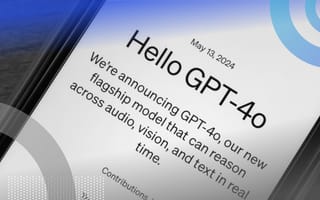Open AI introduced GPT-4o (the o stands for omni) to the world on May 13, 2024. This article highlights GPT-4o’s key features and innovations and their effect on user experience and accessibility.
5 Top New Features of GPT-4o
- Real-time translations between languages
- Super-fast average response time (320 milliseconds)
- Enhanced vision capabilities
- Text processing for 50-plus languages
- A clean and fast user interface
Overall, GPT-4o is twice as fast and 50 percent cheaper than GPT-4 Turbo and has a rate limit five times higher than GPT-4T. It boasts a 128K context window and a knowledge cutoff of October 2023, making it a more efficient choice for developers and users alike. Its advancements in speed and cost-efficiency are not just numbers but translate into real-world efficiency and accessibility for a broader range of applications.
Broadly speaking, GPT-4o introduces multimodal capabilities, real-time interaction and responsiveness, enhanced vision capabilities, multilingual support and other features that underscore the power of artificial intelligence. Here’s a look at the new features.
Multimodal Capabilities
GPT-4o introduces a groundbreaking step toward natural human-computer interaction by handling text, audio, and image inputs and outputs. This capability allows users to engage with the AI in a more versatile manner, making it significantly better at understanding vision and audio compared with previous models. The integration of these modalities into a single model means GPT-4o can process any combination of data types at the same speed, enhancing its ability to engage in intuitive interactions with users.
Real-Time Interaction and Responsiveness
GPT-4o can respond to audio inputs in as little as 232 milliseconds, with an average response time of 320 milliseconds. This speed is comparable to human response times in conversations, facilitating more natural and fluid interactions. The model’s real-time conversational capabilities are further enhanced by its ability to handle and respond to questions almost instantly, ensuring a smooth user experience.
Enhanced Vision Abilities
GPT-4o’s vision capabilities enable the model to process and respond to visual inputs effectively. This feature allows the AI to understand and generate text based on visual inputs, such as describing or responding to content in uploaded images or screenshots. These enhanced vision abilities surpass existing models in understanding and discussing images, offering users new ways to interact with AI.
Multilingual Support
GPT-4o supports more than 50 different languages and shows significant advancements in text processing for non-English languages. The model’s ability to communicate smoothly in several languages, including Japanese and Italian, makes it an invaluable tool for global communication as it allows for seamless language switching during conversations.
This multilingual support, coupled with real-time translation capabilities, underscores GPT 4o’s role in breaking down language barriers and fostering understanding among diverse user groups.
Free Usage Model
GPT-4o boosts accessibility by providing free users with capabilities that were previously exclusive to Plus subscribers. This model ensures that all users have the opportunity to experience the advanced features of GPT-4o, including its multimodal interaction capabilities, which allow for the processing of text, audio and image inputs and outputs.
Free users can now access GPT-4o with certain usage limits. When these limits are reached, ChatGPT automatically transitions to GPT-3.5, ensuring uninterrupted service. This approach democratizes access to cutting-edge AI, allowing a broader audience to explore its potential.
More Subscriber Benefits
For users seeking enhanced capabilities, the Plus plan offers five times the usage limit of the free version, enabling more extensive interaction with GPT-4o. Subscribers benefit from increased capacity and retain access to GPT-4 when exceeding their GPT-4o limit.
This tiered model caters to diverse user needs, from casual explorers of AI to power users requiring substantial computational resources for their projects. The introduction of GPT-4o in the API as a text and vision model, which is twice as fast and has five times higher rate limits compared with GPT-4 Turbo, further underscores the value offered to developers and enterprise users.
User-Friendly Interface
GPT-4o’s revamped user interface features a cleaner design and easier navigation, enabling users to quickly find and use the features they need. Adjustments to response lengths, selection of conversation modes and other customizations are now more accessible, thanks to the intuitive layout of settings and options.
OpenAI’s commitment to making AI tools more accessible is evident in the launch of a new desktop app and a refreshed UI, which includes more conversational interaction capabilities and the ability to share videos as a starting point for discussions. These improvements aim to make the interaction with ChatGPT as natural and seamless as possible, reflecting a significant leap forward in user experience and accessibility.
More Collaborations and Integrations
The adaptability of GPT-4o allows for its integration into various systems, improving user experiences and business processes. One significant integration is with WorkBot, which capitalizes on GPT-4o’s capabilities to automate complex tasks and workflows, thereby enhancing productivity and decision-making in organizational settings.
GPT-4o Limitations and Challenges
Despite the strides made, GPT-4o inherits some of the challenges faced by earlier models, such as hallucinations. Its comprehension of events beyond 2023 remains a work in progress, indicating room for improvement in factual accuracy and relevance. These limitations highlight the ongoing journey of refinement and learning for even the most advanced AI models.
In summary, GPT-4o represents a significant evolution in OpenAI’s offerings, setting new benchmarks in speed, cost-efficiency and multimodal capabilities.




